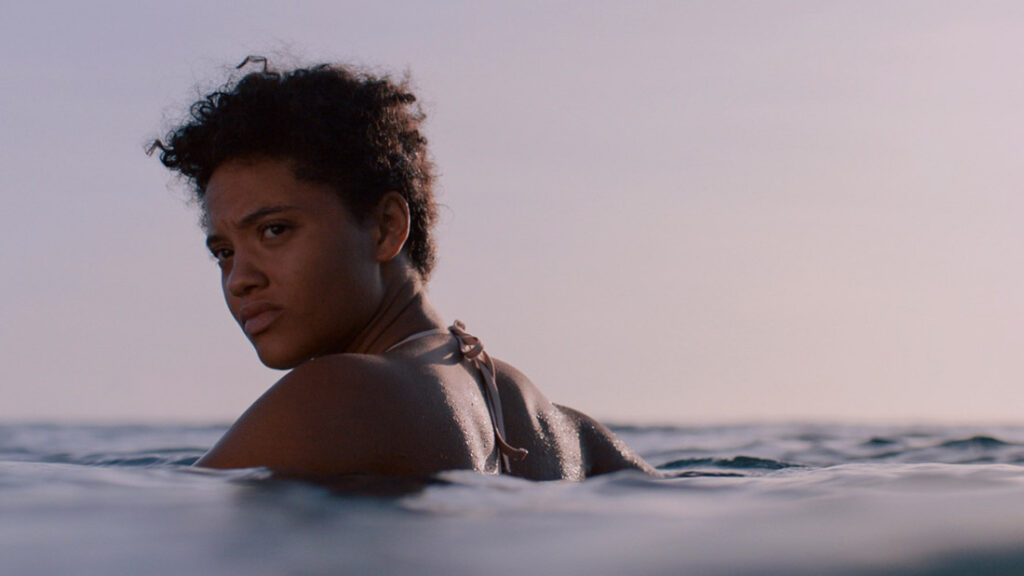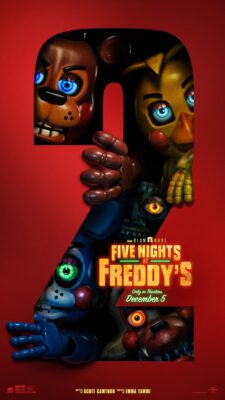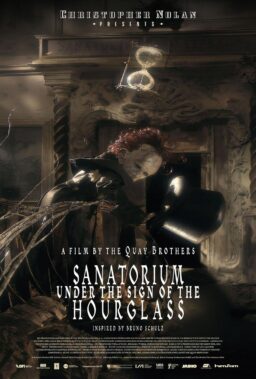A young woman washes up on a deserted island in the opening scene of J.D. Dillard’s great “Sweetheart,” a creature feature with practical effects and fascinating thematic undercurrents that could be pitched as “’Cast Away’ meets ‘Cloverfield.’” We will learn that the woman is named Jen (Kiersey Clemons), and she has a fellow survivor who is severely injured. Jen pulls him to safety and rushes to get a coconut to provide water for him. By the time she returns, he’s dead. She’s in the middle of nowhere, and quickly discerns that this small island is empty. Now the water around it is another story.
Revealed in a series of wonderful limited perspective sequences in which we only see glimpses of what’s going on, we learn that this island has a regular visitor, a massive creature that walks on two legs and bleeds black blood, and can move on land or in the water. It’s sort of humanoid, sort of a wolfman, and sort of alien, and it drags the body of Jen’s dead friend into the underwater hole in which it lives. The days are safe, but the nightmare returns every night. Jen has to do something. She has to find a way to hide, a way to fight, or a way to escape.
The concept of something awful that returns at night can clearly be read as a metaphor for depression, mental illness, dependency—take your pick—but the film unfolds in an interesting way I won’t spoil but that also adds a textual layer of empowerment to Jen’s story. We learn more about how Jen got here and where she was before, and the whole thing takes on a symbolic undercurrent of a woman taking control of her life and destroying that which stalks her and threatens her on a nightly basis.
It’s also just a wicked cool creature feature. Dillard clearly didn’t have much of a budget, but he makes the most of it, keeping the antagonist of the piece hidden for the majority of the movie (but not avoiding getting to the “good stuff” eventually). Dillard takes genuine risks, allowing a large portion of the film to be silent. A lesser filmmaker would have incorporated flashbacks or had Jen talk to herself, but Dillard trusts Clemons to carry it almost silently for long stretches, and she completely conveys the believability of her predicament. So much of the success of a creature feature comes down to the lead actor or actress selling the peril more than anything else, and Clemons does exactly that. It’s a really fun movie that’s both old-fashioned and progressive at the same time. Watch for it.

My final midnight film of Sundance 2019 was Patrick Brice’s “Corporate Animals,” a horror-comedy that’s easy to shorthand as “’Alive’ meets ‘Office Space.’” Yes, the “Alive” in which people are stranded and forced into cannibalism. Imagine that potential dilemma with your co-workers. Who would you eat first? And how much would you potentially enjoy eating your horrible boss?
Demi Moore plays Lucy, the ruthless CEO of a company called Incredible Edibles, which provides edible cutlery. Worried about all that plasticware screwing up the environment? Just eat your fork! It’s not a bad idea but Lucy is clearly horrible at her job, and there are rumors that the company is going under. To build morale, she takes her employees on a trip to New Mexico, where she pushes them into a cave exploration led by a guide named Brandon (Ed Helms). It’s not long before the entire group is stuck in a cave, and they start basically going crazy as long-festering resentments and secrets come to the surface. A solid cast that includes Jessica Williams, Karan Soni, Dan Bakkedahl, and Nasim Pedrad gets stuck in the cave too.
Brice does his best to keep “Corporate Animals” moving but its problems are two-fold. One, it feels like it’s trying to play with hot-button issues like representation and female CEOs, but it doesn’t have the teeth to really be called a satire or any kind of social commentary. It’s just using them as window dressing. Even worse, it’s just not funny. Moore can’t find the rhythms for this non-character, and too many of the film’s bad jokes are repeated in the hope they’ll be funny the second time. This is the kind of thing that may work on cable or late at night, but after a couple strong days, and the overall strength of this year’s Midnight program, it really didn’t work for me.












